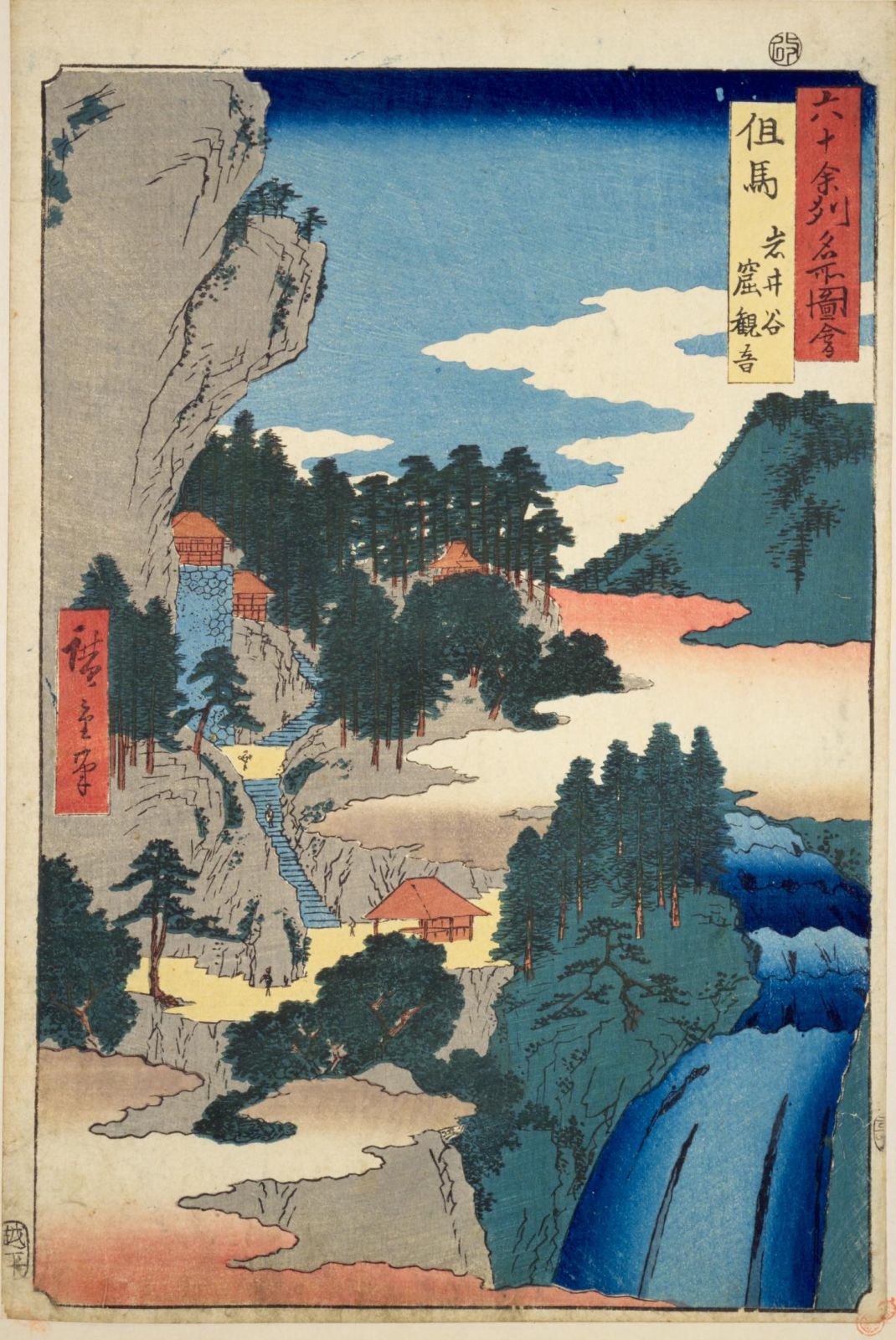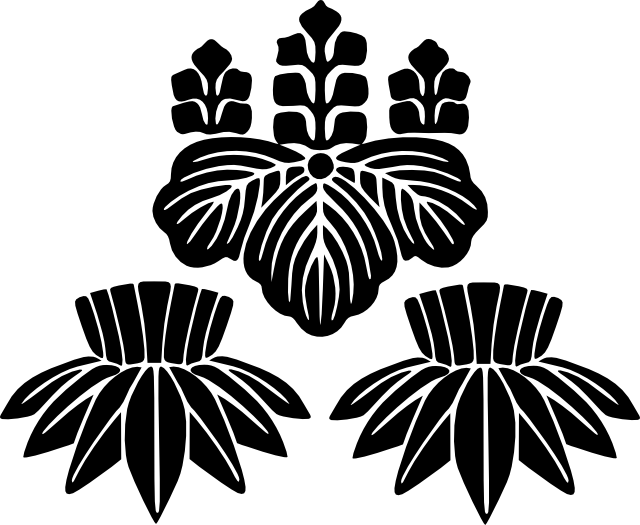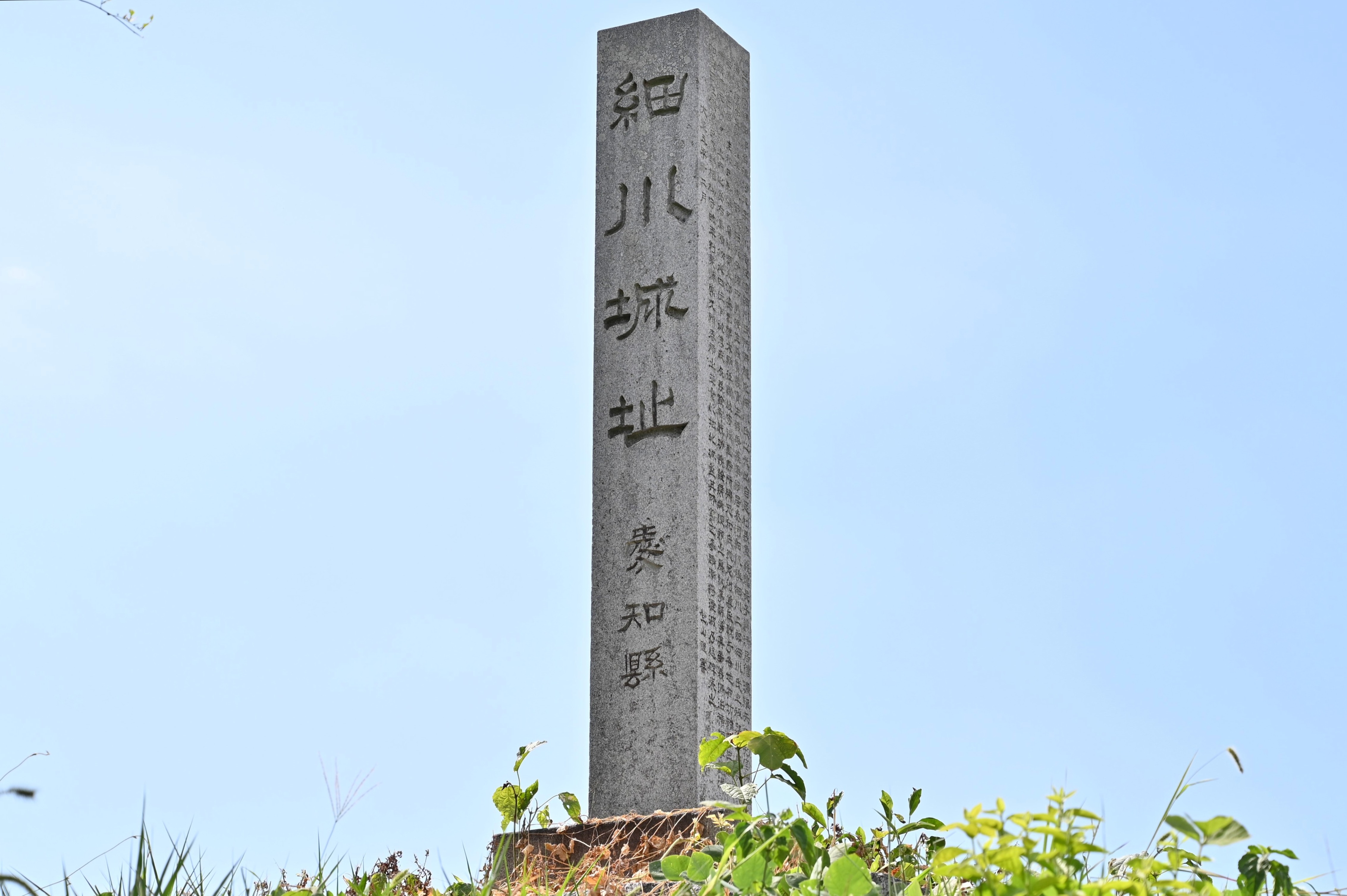|
Kuroi Castle
was a Sengoku period Japanese castle located in what is now the Kasuga-cho neighborhood of the city of Tamba Hyōgo Prefecture, Japan. It was also called or . Famous as the birthplace of Lady Kasuga, the wet nurse of Tokugawa Iemitsu, it ruins have been protected as a National Historic Site since 1989. History Kuroi Castle is located on a 350-meter mountain at the middle of Hikami basin, protected on three sides by rivers. the valley is a cul-de-sac to the northwest of the Sasayama basin, which contained Sasayama Castle. Spreading across three ridges of the mountain, the castle was one of the largest in Tanba Province, along with Yakami Castle and Yagi Castle. A fortification was originally built in this location in the early Muromachi period by the Akamatsu clan, who ruled the area for around 120 years. It then came into the hands of the Ogino clan, a cadet branch of the Akai clan, who in turn were a cadet branch of the Inoue clan, originally from Shinano Province. Originall ... [...More Info...] [...Related Items...] OR: [Wikipedia] [Google] [Baidu] |
Tamba, Hyōgo
270px, Autumn foliage at Sekigan-ji is a city in Hyōgo Prefecture, Japan. , the city had an estimated population of 62,152 in 26090 households and a population density of 130 persons per km².The total area of the city is . Geography Tamba is located in an inland basin at an average elevation of 100 meters above sea level in the eastern part of the prefecture. It is located in the mountains between the Seto Inland Sea and the Sea of Japan. The uppermost stream of the Kako River system and the uppermost stream of the Yura River system, flow through the city, which has the lowest central watershed in Japan except for Hokkaido. The 35 degree east longitude meridian passes through the city. Neighboring municipalities Hyōgo Prefecture *Tamba-Sasayama * Nishiwaki * Asago *Taka Kyoto Prefecture *Fukuchiyama Climate Tamba has a humid subtropical climate (Köppen climate classification ''Cfa'') with hot summers and cool to cold winters. Precipitation is significantly higher in summer ... [...More Info...] [...Related Items...] OR: [Wikipedia] [Google] [Baidu] |
Yagi Castle
270px, Aerial photograph showing the relative locations of the old castle, new castle and Kamakura-period mansion is a late Kamakura period Japanese castle located in the Yōka neighborhood of the city of Yabu, Hyōgo Prefecture, Japan. Its ruins have been protected as a National Historic Site since 1997. The ruins are regarded as historically important, as the site includes the traces of a Kamakura period feudal mansion, Muromachi period mountain castle with clay walls, and the ruins of a Sengoku period castle with stone walls. History Yagi Castle is situated in a strategic border area between the Kansai region and the San'in region, overlooking the ancient San'in highway connecting Tajima Province with Inaba Province. The castle has town locations. One is at Mount Tsuchiyama, with an elevation of 409 meters (which is called the "Yagi Kojō", or "old Yagi Castle") and the other at Mount Shiroyama, with an elevation 303 meters, with the two areas connected by a 450-meter ridge ... [...More Info...] [...Related Items...] OR: [Wikipedia] [Google] [Baidu] |
Takeda Clan
The was a Japanese samurai clan active from the late Heian period until the late 16th century. The clan was historically based in Kai Province in present-day Yamanashi Prefecture. The clan reached its greatest influence under the rule of Takeda Shingen, one of the most famous rulers of the period. History Origin The Takeda are descendants of the Emperor Seiwa (858–876), the 56th Emperor of Japan, and are a branch of the Minamoto clan (Seiwa Genji), by Minamoto no Yoshimitsu (1056–1127), son of the '' Chinjufu-shōgun'' Minamoto no Yoriyoshi (988-1075), and brother to the famous Minamoto no Yoshiie (1039–1106). Minamoto no Yoshikiyo (1075–1149), son of Yoshimitsu, was the first to take the name of Takeda, which he took when his father granted him Takeda domain in Hitachi Province; thereafter, he was known as Takeda Yoshikiyo. Kamakura to early Azuchi–Momoyama periods In the 12th century, at the end of the Heian period, the Takeda family-controlled Kai Province. Alon ... [...More Info...] [...Related Items...] OR: [Wikipedia] [Google] [Baidu] |
Oda Nobunaga
was a Japanese ''daimyō'' and one of the leading figures of the Sengoku period. He is regarded as the first "Great Unifier" of Japan. Nobunaga was head of the very powerful Oda clan, and launched a war against other ''daimyō'' to unify Japan in the 1560s. Nobunaga emerged as the most powerful ''daimyō'', overthrowing the nominally ruling shogun Ashikaga Yoshiaki and dissolving the Ashikaga Shogunate in 1573. He conquered most of Honshu island by 1580, and defeated the ''Ikkō-ikki'' rebels in the 1580s. Nobunaga's rule was noted for innovative military tactics, fostering of free trade, reforms of Japan's civil government, and the start of the Momoyama historical art period, but also for the brutal suppression of those who refused to cooperate or yield to his demands. Nobunaga was killed in the Honnō-ji Incident in 1582, when his retainer Akechi Mitsuhide ambushed him in Kyoto and forced him to commit . Nobunaga was succeeded by Toyotomi Hideyoshi, who along with Toku ... [...More Info...] [...Related Items...] OR: [Wikipedia] [Google] [Baidu] |
Konosumiyama Castle
was a Muromachi to Sengoku period Japanese castle located in the Izushi neighborhood of the city of Toyooka, Hyōgo Prefecture, Japan. Its ruins, along with the ruins of nearby Arikoyama Castle have been protected as a National Historic Site since 1934 under the designation "Yamana clan castle ruins". History Konosumiyama Castle is located approximately two kilometers north of the center of former Izushi city and three kilometers from the southeast edge of the Toyooka basin in northern Hyogo. The location controlled the ancient San'in highway connecting the Kinai region of Japan with the San'in region and was near the political and economic center of Tajima Province. The area came under the control of the Yamana clan, a cadet branch of the Nitta clan in the Muromachi period. The Yamana clan had close relations with the Ashikaga shogunate and was one of four clans with hereditary rights to the position of ''Samurai-dokoro''. The Yamana leveraged their position to eventually ... [...More Info...] [...Related Items...] OR: [Wikipedia] [Google] [Baidu] |
Takeda Castle
was a Sengoku period Japanese castle located in the Wadayama neighborhood of the city of Asago, in the northern part of Hyōgo Prefecture, Japan. It is located north of Himeji, and north-west of Kyoto, and is situated some 353 metres above sea level It is often referred to locally as the "Machu Picchu of Japan". Its ruins have been protected as a National Historic Site since 1943. History Takeda Castle is located on Mount Shiroyama at a strategic location commanding the intersection of the San'indo highway from Tanba to Inaba Province connects with the road south to Harima Province and the Seto Inland Sea. The castle is also close to the Ikuno mine, one of the largest silver mines in Japan during the Muromachi period. The area came under the control of the Yamana clan, a cadet branch of the Nitta clan, in the Muromachi period. The Yamana clan had close relations with the Ashikaga shogunate and was one of four clans with hereditary rights to the position of ''Samurai-dokor ... [...More Info...] [...Related Items...] OR: [Wikipedia] [Google] [Baidu] |
Tajima Province
was a province of Japan in the area of northern Hyōgo Prefecture. Tajima bordered on Tango and Tanba to the east, Harima to the south, and Inaba to the west. Its abbreviated form name was . In terms of the Gokishichidō system, Tajimao was one of the provinces of the San'indō circuit. Under the ''Engishiki'' classification system, Tajima was ranked as one of the "superior countries" (上国) in terms of importance, and one of the "near countries" (近国) in terms of distance from the capital. The provincial capital was located in what is now the city of Toyooka. The ''ichinomiya'' of the province is the Izushi Shrine also located in Toyooka. The area of the province was 2099.01 square kilometers. History Early history The early history of the Tajima region is uncertain. There appear to have been two power centers. The Tajima ''Kuni no miyatsuko'' ruled in eastern Tajima (present-day Asago District and Yabu District) and are mentioned in the ''Kujiki''. They tenuously ... [...More Info...] [...Related Items...] OR: [Wikipedia] [Google] [Baidu] |
Yamana Clan
The was a Japanese samurai clan which was one of the most powerful of the Muromachi period (1336-1467); at its peak, members of the family held the position of Constable (''shugo'') over eleven provinces. Originally from Kōzuke Province, and later centered in Inaba Province, the clan claimed descendance from the Seiwa Genji line, and from Minamoto no Yoshishige in particular. The clan took its name from the village of Yamana in present-day Gunma Prefecture. They were valued retainers under Minamoto no Yoritomo, and counted among his ''gokenin''. The Yamana were among the chief clans in fighting for the establishment of the Ashikaga shogunate, and thus remained valued and powerful under the new government. They were Constables of five provinces in 1363, and eleven a short time later. However, members of the Yamana clan rebelled against the shogunate in the Meitoku Rebellion of 1391 and lost most of their land. Yamana Sōzen (1404 – 1473), likely the most famous member of the ... [...More Info...] [...Related Items...] OR: [Wikipedia] [Google] [Baidu] |
Onin War
Onin may refer to: * Ōnin, a Japanese era ** Ōnin War * Onin peninsula, on the Bomberai Peninsula Bomberai Peninsula ( id, Semenanjung Bomberai), otherwise known as the Bird's Beak Peninsula ( id, Semenanjung Paruh Burung), is located in the Western New Guinea region, opposite to and to the south of the Bird's Head Peninsula. To the west lies ... of Indonesian Papua * Onin language, an Austronesian language spoken on the peninsula {{Disambiguation ... [...More Info...] [...Related Items...] OR: [Wikipedia] [Google] [Baidu] |
Shugo
, commonly translated as “(military) governor,” “protector,” or “constable,” was a title given to certain officials in feudal Japan. They were each appointed by the ''shōgun'' to oversee one or more of the provinces of Japan. The position gave way to the emergence of the ''daimyōs'' (大名, feudal lords) in the late 15th century, as ''shugo'' began to claim power over lands themselves, rather than serving simply as governors on behalf of the shogunate. The post is said to have been created in 1185 by Minamoto no Yoritomo to aid the capture of Yoshitsune, with the additional motivation of extending the rule of the shogunate government throughout Japan. The ''shugo'' (military governors) progressively supplanted the existing ''kokushi'' (civil governors), who were appointed by the Imperial Court in Kyoto. Officially, the ''gokenin'' in each province were supposed to serve the ''shugo'', but in practice, the relationship between them was fragile, as the gokenin were ... [...More Info...] [...Related Items...] OR: [Wikipedia] [Google] [Baidu] |
Hosokawa Clan
The is a Japanese Samurai kin group or clan. Ancestors # Emperor Jimmu # Emperor Suizei # Emperor Annei # Emperor Itoku # Emperor Kōshō # Emperor Kōan # Emperor Kōrei # Emperor Kōgen # Emperor Kaika # Emperor Sujin # Emperor Suinin # Emperor Keikō # Yamato Takeru # Emperor Chūai # Emperor Ōjin # Wakanuke Futamata no Kimi # Ohohoto no Kimi # Ohi no Kimi # Ushi no Kimi # Emperor Keitai # Emperor Kinmei # Emperor Bidatsu # Prince Oshisaka # Emperor Jomei # Emperor Tenji # Prince Shiki # Emperor Kōnin # Emperor Kanmu # Emperor Saga # Emperor Ninmyō # Emperor Montoku # Emperor Seiwa # Prince Sadazumi # Minamoto no Tsunemoto # Minamoto no Mitsunaka # Minamoto no Yorinobu # Minamoto no Yoriyoshi # Minamoto no Yoshiie # Minamoto no Yoshikuni # Minamoto no Yoshiyasu # (Ashikaga) Minamoto no Yoshikiyo # (Hirosawa) Ashikaga Yoshizane # (Ashikaga) Hosokawa Yoshisue History The clan was descended from the Seiwa Genji, a branch of the Minamoto clan, and ultimately from Emperor Se ... [...More Info...] [...Related Items...] OR: [Wikipedia] [Google] [Baidu] |




